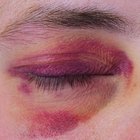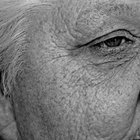
Ronnie Kaufman/Blend Images/Getty Images
Testosterone is a hormone that is produced in large amounts in the testes of men, in small amounts in the ovaries of women and also in small amounts in the adrenal glands of both men and women. Testosterone is responsible for the development of many of the male sexual characteristics, including the external genitalia, facial hair and increased muscle mass. Several chemicals can stop the production of testosterone, including prescription medications and other more commonly available substances.
LHRH Agonists
Prescription drugs known as LHRH agonists stop the production of testosterone by interfering with the hormone LHRH, which stands for luteinizing-hormone-releasing hormone. LHRH is also sometime known as gonadotropin-releasing hormone, abbreviated GnRH. LHRH causes luteinizing hormone, or LH, to be secreted from the pituitary gland. LH then stimulates the testes to produce testosterone, explains the Fox Chase Cancer Center. Blocking the action of LHRH causes the pituitary gland to produce less LH, resulting in reduced production of testosterone. High levels of LHRH agonists have the same effects as surgically removing the testicles, and for this reason, treatment with LHRH is sometimes called chemical castration. LHRH agonists are sold under the brand names Zoladex and Lupron.
Anabolic Steroids
Anabolic steroids are compounds that mimic the activity of naturally occurring testosterone. For this reason, anabolic steroids, which are also known as anabolic-androgenic steroids, are sometimes abused by athletes seeking to increase their muscle mass and boost athletic performance. Use of anabolic steroids often leads to decreased blood levels of testosterone, reports the United States Department of Health and Human Services. Doctors suspect this occurs because the anabolic steroids act like normal testosterone and trick the body into thinking it does not need to produce more testosterone.
Alcohol
Several studies have found that consumption of alcohol reduces synthesis of testosterone in the body, according to the National Institute on Alcohol Abuse and Alcoholism. Doctors do not yet fully understand why alcohol has this inhibitory effect on testosterone biosynthesis. Current research suggests that alcohol inhibits one more more steps of the biochemical pathway that produces testosterone.
Ketoconazole
A medication called ketoconazole is sometimes used to treat fungal infections. Studies have found that ketoconazole inhibits the production of testosterone in men, explains an article in the Journal of Pharmacobio-Dynamics. One part of the ketoconazole drug called imidazole inhibits the biochemical pathway that leads to the production of testosterone.
Related Articles

Can Drinking Nettle Tea Reduce DHT ...

How Exercise Increases Hair Growth

What Are the Dangers of 6 Oxo?

What Are the Causes of Hair Shedding in ...

Is it Bad to Shave Facial Hair for ...

Chasteberry for Acne

Fraxel Laser Treatment Dangers

Subungual Warts and Treatment

How to Stop Facial Hair Growth for Men

Difference Between Women's Rogaine & ...

How to Get Rid of Facial Hair After a ...

Recommended Daily Dosage of Saw ...

How to Get Rid of Stomach Hair ...

Skin Care Products That Contain ...

Are There Herbal Treatments for ...

Bromelain & Bruising

How Children Are Affected When Living ...

Is Soy Milk Casein-Free?

Treatment of Razor Bumps for Black Women

Facts on Natural Hair Changing Color
References
- Fox Chase Cancer Center: Hormone Therapy for Prostate Cancer Patients
- Medline Plus: Prostate Cancer
- National Institute on Alcohol Abuse and Alcoholism: Alcohol and the Male Reproductive System
- "Journal of Pharmacobio-Dynamics"; Inhibition of Testosterone Biosynthesis in Testicular Microsomes by Various Imidazole Drugs. Comparative Study with Ketoconazole
Writer Bio
Matthew Busse has pursued professional health and science writing since 2007, writing for national publications including "Science Magazine," "New Scientist" and "The Scientist." Busse holds a doctorate in molecular biology from the University of California-San Diego.
Photo Credits
Ronnie Kaufman/Blend Images/Getty Images